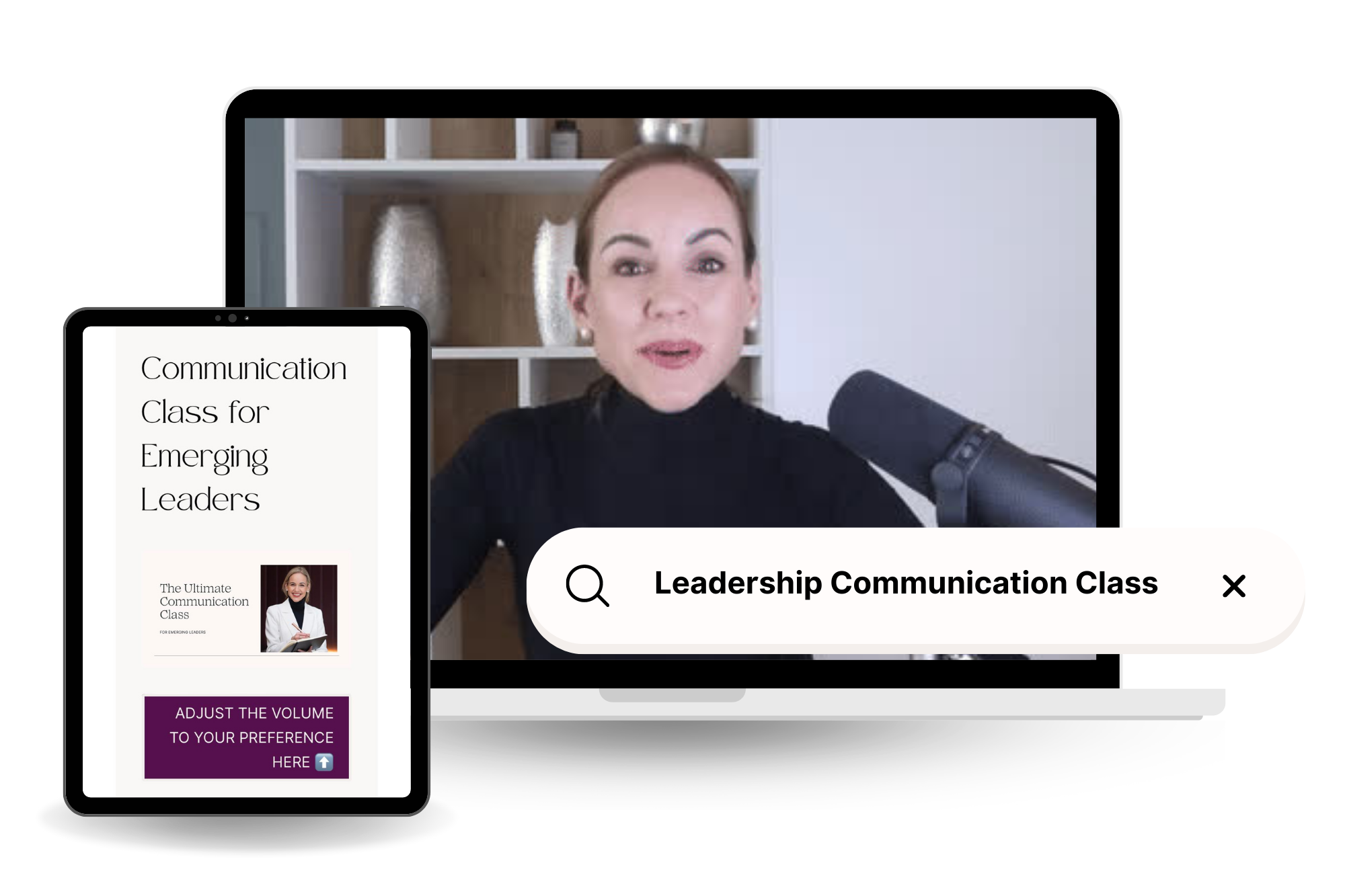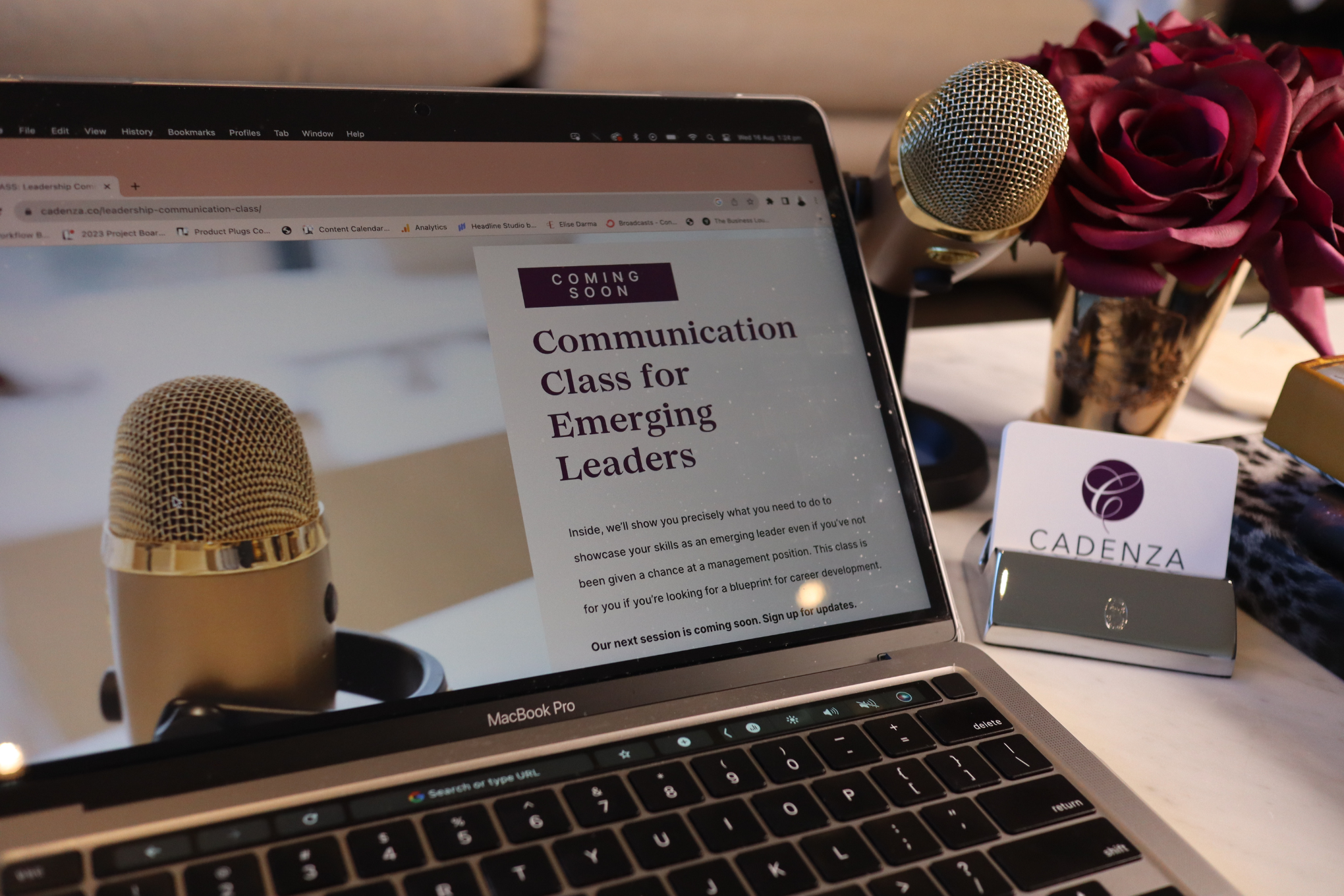Career Communication
How to Appear More Powerful Using your Personal Presentation as a Petite Person
Uncover visual & verbal personal branding strategies to feel more empowered and assert yourself as a petite professional.

If you’re a petite millennial leader or entrepreneur, this article will provide actionable advice on how to appear more powerful through posture, gestures and speaking techniques that increase your gravitas.
You’ll learn how to brand your visual and verbal communication to help you communicate influence. Our focus will be on strategies to feel more empowered.
We will look at what you can do if you feel like people underestimate your discernment, influence and shrewd expertise using personal presentation tactics.
This blog post is best digested in 3 parts:
- Check the tips for summarised below
- Watch the vlog for more detailed training.
- If you want to take it further- sign up for the Ultimate Leadership Communication Class.
The Communication Class for Emerging Leaders is a FREE masterclass.
In the class, we will tackle the speaking behaviours you need, the critical leadership reputation principles, the magic formula for building relationships, and the red flags in your leadership reputation management. We will also discuss a research-backed way to understand your communication style. Sign up now!

Introduction to Petite Power Branding
If you’re petite and elegant and wondering how to brand yourself to have increased executive presence as well as how to appear more powerful and confident, consider that:
Executive presence is primarily determined by your communication and ability to create authentic relationships that grow your influence more than your height and size.
Your demeanour is much more vital than your size, so don’t let your slight frame or elegance hold you back. You can be elegant and feminine and still build your professional presence, and if you refine your communication, you can gain confidence interacting in leadership roles and still feel authentic.
Charismatic Communication creates Executive Presence more than your size, height or assertiveness.
If you’ve reached a point where you want to adjust how you position yourself socially or professionally so that people take you more seriously and show you increased respect, take care of what goals you choose for your Communication.
Having a petite frame, opting for an elegant wardrobe and striving to use good etiquette can make you a target for toxic and controlling behaviour. People can easily confuse elegant communicators as pushovers because using polite language that embraces the rules of tact confuses boundary breakers.
Even if you’ve been disappointed in the past with toxic friends or abrasive colleagues, or demeaning contacts, take care with what Communication approaches you use to increase your power and authority because there is a research base around this. We don’t want to confuse bad behaviour that often disempowers with confident communication.
Aggressive Communicators
Aggressive communicators are power-seeking, so they use dominating, ego-centric and commandeering language tools to coerce.
Powerful Communicators
Powerful communicators operate differently. They gain influence, respect and authority through powerful personalities, not aggression.
Influential communicators operate differently.
It all comes down to charisma, warmth, rapport and openness, quite the opposite tools of what power-seeking individuals use.
Learning charismatic communication techniques will assist you in achieving affirming and inspiring conversations at work and creating memorable and heartfelt impressions with people around you. When we consult with our clients, emerging leaders and executives at Cadenza, we show them how to integrate new techniques backed by the latest research around speaking with improved consideration of your conversation partner and position your message to be mutually relevant and engaging.
We can use various concrete tools to achieve this, particularly learning to command attention by producing a captivating voice cadence.
Command attention by producing a captivating voice cadence.
The ability to produce a powerful voice is advantageous if you have a genetically light frame.
Here are some key aspects you’ll want to achieve with your voice tone that research shows will build your authority and credibility:
- Learn to warm up your voice daily to develop your control over the vocal muscle to achieve increased consistency and stamina when speaking.
- Aim for a clear and audible tone.
- Work on your intonation patterns.
- Reduce verbal trail-offs at the end of sentences- this can make your message sound less secure.
- Work on your vocal projection, being petite doesn’t mean you need to be small vocally.
It’s always encouraging to consider that voice tone alters the “social impressions of speakers.” Your listeners evaluate your interpersonal relevance based on your sound (Caballero, 2021). You can make many gains with executive presence once you add vocal tone skills and diction as a new goal for your professional development.
Play and Experiment with Proxemics
If you’re petite, you may be self-deprecating with your body language by positioning yourself in the corner, taking up less space at tables, entering a room hunched over or reducing your body’s potential to position itself more expansively.
You can experiment with proxemics to adjust your personal presentation and appear more powerful and confident.
Definition
“Proxemics is the study of the nature, degree and effect of the spatial separation individuals naturally maintain (as in various social and interpersonal situations) and how this separation relates to environmental and cultural factors.” Merriam-Webster
You might find this goal beneficial:
I will maintain my postural symmetry and interact expansively no matter who I talk with and how I feel.
When we are shorter or slighter than others, our body space and position are relationally smaller, but it does not mean our communication gestures should be.
A fundamental principle of engaging stage performance in theatres is to move with expansiveness and to create larger and broader gestures, even though the scene around the actor or singer is usually proportionally larger. Aim for expansive symmetry. You might like to check our expert guide on how to carry yourself at work here.
Watch our vlog for more ideas on how to appear more powerful and gain practical examples you can trial with your attire.
Proxemics refers to the study of how space and distance influence communication. And if we consider research into showcasing executive presence more effectively, aiming for expansive gestures can serve you well. Just as we want to avoid aggressive and domineering language, we also want to avoid body language that serves to dominate.
Work on maintaining your space. Even though you may be petite doesn’t mean you should get less space.
Maintain your access to space with your body. Here are a few personal presentation tips to assist:
- Open the angle. Open the angle. If you are smaller than another person speaking to you face to face, step back, open the angle and bring eye contact more parallel.
- Create bigger body angles by sitting in the centre of your chair, maintaining symmetry at the neck and creating a right angle at the hip and torso. This will give you more equilibrium and enable you to secure increased visual presence than if you compress yourself inwards and reduce your limbs’ access to space.
- Try sitting at the head or centre of a table at a dinner party, team meeting or coffee date; if you’re not inclined to go for that position, you’ll find it interesting.
- Maintain your half of the seat on a tram or train, don’t compress and squeeze into the corner just because someone is manspreading. This is a matter of self-respect and communicates laws of etiquette that, unfortunately, many people forget on public transport these days.
- Strive to keep everyone at arm’s length in professional social interactions. Formal communication occurs 120-365 cm away from our body axis, so this is the appropriate space you need when interacting at work. Maintain this space as it is your professional boundary.
Minimise excess visual body noise when communicating.
Communication works better when we are expressive, expansive and warm. So while it is vital to avoid looking stiff, take care that you minimise fidgeting, playing with your hair or moving your hands with micro-movements.
Excess body movement will distract from the crux of your message, reduce your poise and composure and make you appear less powerful and confident. Communication is more than just words; it’s about how you present yourself to the world. Whether speaking in public, engaging in a business meeting, or simply conversing with a friend, your demeanour and body language play a significant role in conveying your message effectively.

Avoid power posturing and contrived behaviours.
Powerful communicators aim to be streamlined and warm, not abrasive and superior.
In contrast, power seekers use pretentious posturing like manspreading, steepling, and backward inclining and seek to reduce your access to space.
Power seekers tend to use contrived and visually pretentious gestures. Here are a few examples of behaviours that can look inauthentic.
- Steepling – superiority
- Arms folded with thumbs pointing upward – superiority
- Hands-on hips – dominating
- Chair straddling – aversion
- Spreading – dominating
- Peering over your glasses – intimidating
Just as we want to avoid aggressive and domineering language, we also want to avoid body language that serves to dominate. Use gesture, posture and gait to show self-respect without exerting superiority.
Gain control of your facial expressions.
Calm and warm facial expressions with an authentic smile and open gaze will position you as amicable, confident and approachable. When we experience increased performance pressure, it’s impossible to mask our facial expressions. Paul Ekman’s work on microexpressions revealed that the face flashes signals that surpass all language barriers in a split second, often revealing what you are thinking, such that masking your thoughts can be challenging. If you are concerned that it is hard to protect your interactions and appear composed and confident when dealing with difficult people and challenging professional circumstances, the most effective way to gain control of your facial expressions is to learn self-regulation techniques from a communication expert. When I work with emerging leaders and executives, I provide techniques and strategies that will allow you to protect your confidence and self-regulation skills under pressure. Social intelligence frameworks and speaking comfort playbooks can assist you in retaining your poise and composure, even if it feels like the sky is falling!
Warren Buffet discussed the importance of self-regulation when he talked about how:

Social intelligence tools allow you to respond with logic so that you can be composed no matter the pressure you face and can be one of the most effective ways to garner your professional reputation.
Did you ever wish you could fine-tune your speaking response skills to nail unexpected questions confidently?
You may notice team members caught off guard, under pressure or struggling to control their emotions when interacting with colleagues, clients and stakeholders.
Self-regulation difficulties leave traces commonly observable in a team member’s speaking style.
Look for opportunities to communicate outside of your comfort zone.
One of the most effective ways to develop your executive presence is to embrace opportunities to take on communication activities that don’t come naturally or feel intimidating.
Here are a few examples of how that can work for you.
If you feel bashful and anxious about public speaking, don’t avoid it. New communication activities and contexts can be intimidating, but nothing empowers you more than taking them on and acquiring new soft skills.
Avoid public speaking? Enrol in an evidence based public speaking program with the team at Cadenza.
Feel reticent to be assertive and set boundaries at work? Consider working with an executive speaking consultant to learn how to integrate assertive communication into your suite of speaking skills.
Embarrassed or awkward selling your products and services confidently? Work with a communication specialist to fine tune your sales conversations with clients.
Fearful of conflict and customer complaints? Train deeper in social intelligence and conflict de-escalation.
At Cadenza, we’re committed to quality, research-informed strategies, consultations and methods that build your professional communication skills. If you’re noting a communication barrier blocking your path, you can always contact us to discuss approaches to forging a clear and confident solution.
Your communication style can make, shape or totally sabotage your ability to lead your team or even get into a leadership position in the first place. Which is why we want to give you the speaking tools to get there- faster. So today, we would like to take the opportunity to invite you to sign up for a new on-demand Communication Class for Emerging Leaders.
If you’re aiming to develop into a growth leader, your communication needs to be exceptional. Take your skills further no sooner than now by pausing this video and signing up for my on demand Leadership Communication Class for Emerging Leaders so you can learn the levers to pull if you feel like no one recognises your leadership potential.

Take our Free Masterclass
Communication Class for Emerging Leaders
Normally $94, our 60+ minutes together will give you a high-level look at…
- How you can use your speaking to showcase your leadership abilities more effectively so that you get noticed, not sidelined.
- Why expertise and experience in your field is not always enough to cross the line into a dream leadership role.
- The Key Leadership Reputation Principles you need to focus on to be noticed as a potential leader.
- The magic formula for building relationships through effective professional communication so that you can build iron-clad rapport with all personalities so that you feel comfortable and influential with everyone
- Plus, we’ll also share a research-backed way to understand precisely what your communication style is like so you can 🥇 position your strengths more expertly in job applications or promotion conversations.
Sign up for the class now! ⬇
Remember, you can be elegant and feminine and still build your professional presence. If you refine your communication, you can gain confidence interacting in leadership roles and still feel authentic. Our focus is on maintaining your self-respect and value without appearing superior. Keep it warm, open and clear. The vital professional etiquette rule to observe is to secure executive presence through rapport. Conversational connection through openness and warmth is the first step to influence, and exemplary soft skills are more potent than posing and dominating your contacts. A fusion of confidence, warmth, and authenticity will bring more value and impact to your professional life than power-seeking behaviours.
References
-
Anjali Hans, E. H. (2015). “Kinesics, Haptics and Proxemics: Aspects of nonverbal communication.” IOSR Journal of Humanities and Social Science (IOSR-JHSS).
-
Caballero, J., et al. (2021). “Cortical processing of speaker politeness: Tracking the dynamic effects of voice tone and politeness markers.” Social Neuroscience 16.
-
Canderan, C., Maieron, M., Fabbro, F., & Tomasino, B. (2020). Understanding Body Language Does Not Require Matching the Body’s Egocentric Map to Body Posture: A Brain Activation fMRI Study. Perceptual and Motor Skills, 127(1), 8–35.
Did you enjoy this post? Make sure to subscribe to our YouTube channel to get more content to increase your communication skills!
About the Author
Dr Sarah Lobegeiger de Rodriguez is a Keynote Speaker, Executive Speaking Coach, and Opera Singer who likes to play with words, sounds, and your impact.
Her academic background is in Music Performance, Communication Science and Speech & Language Pathology. She assists executive communication clients all over the world as a communication consultant with strong expertise in CEO, Founder and Entrepreneur communication strategies.
Connect with Sarah on LinkedIn.
© CADENZA
Level 14, 380 St Kilda Road, Melbourne, 3004
Privacy Policy
Terms & Conditions
Position Statement on Racism
